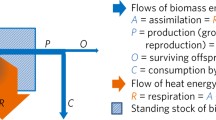Summary
Pontryagin's maximum principle from optimal control theory is used to find the optimal allocation of energy between growth and reproduction when lifespan may be finite and the trade-off between growth and reproduction is linear. Analyses of the optimal allocation problem to date have generally yielded ‘bang-bang’ solutions, i.e. determinate growth: life-histories in which growth is followed by reproduction, with no intermediate phase of simultaneous reproduction and growth. Here we show that an intermediate strategy (indeterminate growth) can be selected for if the rates of production and mortality either both increase or both decrease with increasing body size, this arises as a singular solution to the problem. Our conclusion is that indeterminate growth is optimal in more cases than was previously realized. The relevance of our results to natural situations is discussed.
Similar content being viewed by others
References
Alexander, R. McN. (1982)Optima for Animals. Edward Arnold, London, UK.
Amir, S. and Cohen, D. (1990) Optimal reproductive effort and the timing of reproduction of annual plants in randomly varying environments.J. Theor. Biol. 147, 17–42.
Banks, S.P. (1986)Control Systems Enginering. Prentice-Hall International, Englewood Cliffs, NJ, USA.
Bell, D.J. and Jacobson, D.H. (1975)Singular Optimal Control Problems. Academic Press, London, UK.
Bryson, A.E. and Ho, Y-C. (1969)Applied Optimal Control. Ginn & Co., Waltham, MA, USA.
Charlesworth, B. (1980)Evolution in Age-structured Populations. Cambridge University Press, Cambridge.
Cohen, D. (1971) Maximizing final yield when growth is limited by time or by limiting resources.J. Theor. Biol. 33, 299–307.
Clark, C. (1976)Mathematical Bioeconomics. Wiley, New York, USA.
Gabriel, W. (1982) Modelling reproductive strategies ofDaphnia.Arch. Hydrobiol. 95, 69–80.
Intriligator, M.D. (1971)Mathematical Optimization and Economic Theory. Prentice-Hall, New York, USA.
Ito, Y. (1980)Comparative Ecology. Cambridge University Press, Cambridge, UK.
Iwasa, Y. and Roughgarden, J. (1984) Shoot/root balance of plants: optimal growth of a system with many vegetative organs.Theor. Popul. Biol. 25, 78–105.
King, D. and Roughgarden, J. (1982) Graded allocation between vegetative and reproductive growth for annual plants in growing seasons of random lengths.Theor. Popul. Biol. 22, 1–16.
Kozlowski, J. and Wiegert, R.G. (1987) Optimal age and size at maturity in annuals and perennials with determinate growth.Evol. Ecol. 1, 231–44.
Leon, J.A. (1976) Life histories as adaptive strategies.J. Theor. Biol. 60, 301–35.
Lynch, M. (1980) The evolution of cladoceran life histories.Q. Rev. Biol. 55, 23–42.
Perrin, N. (1992) Optimal resource allocation and the marginal value of organs.Am. Nat. 139, 1344–69.
Perrin, N., Ruedi, M. and Saiah, H. (1987) Why is the cladoceranSimocephalus vetulus (Muller) not a ‘bang-bang strategist’? A critique of the optimal-body-size model.Funct. Ecol. 1, 223–8.
Sasaki, A. and Iwasa, Y. (1991) Optimal growth schedule of pathogens within a host: switching between lytic and latent cycles.Theor. Popul. Biol. 39, 201–39.
Sebens, K.P. (1987) The ecology of indeterminate growth in animals.Ann. Rev. Ecol. Syst. 18, 371–407.
Sibly, R.M. (1989) What evolution maximizes.Funct. Ecol. 3, 129–35.
Sibly, R.M. and Calow, P. (1986) Growth and resource allocation. InEvolutionary Physiological Ecology (P. Calow, ed.), pp. 37–52. Cambridge University Press, Cambridge, UK.
Sibly, R.M., Calow, P. and Nichols, N. (1985) Are patterns of growth adaptive?J. Theor. Biol. 112, 553–74.
Taylor, B. (1985) Effects of food limitation on growth and reproduction ofDaphnia.Arch. Hydrobiol. 21, 285–95.
Taylor, H.M., Gourley, R.S., Lawrence, C.E. and Kaplan, R.S. (1974) Natural selection of life history attributes: an analytical approach.Theor. Popul. Biol. 5, 104–22.
Ziolko, M. and Kozlowski, J. (1983) Evolution of body size: an optimization model.Math. Biosci. 64, 127–43.
Author information
Authors and Affiliations
Rights and permissions
About this article
Cite this article
Perrin, N., Sibly, R.M. & Nichols, N.K. Optimal growth strategies when mortality and production rates are size-dependent. Evol Ecol 7, 576–592 (1993). https://doi.org/10.1007/BF01237822
Issue Date:
DOI: https://doi.org/10.1007/BF01237822




